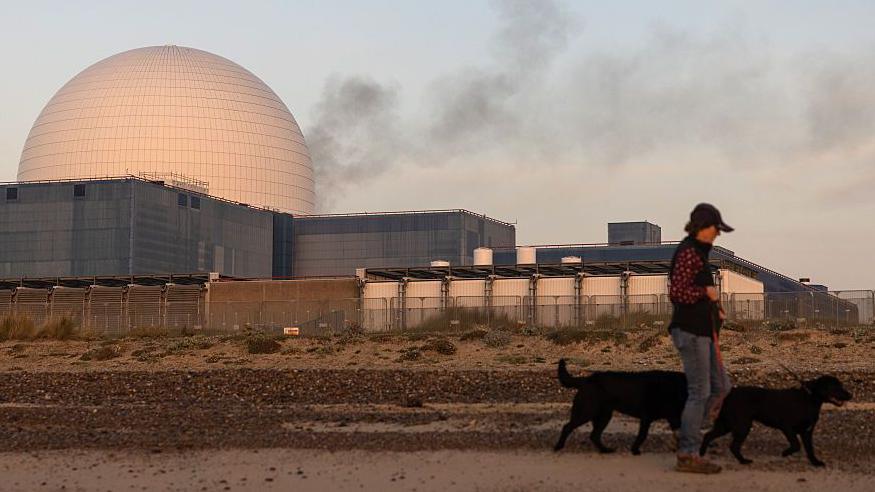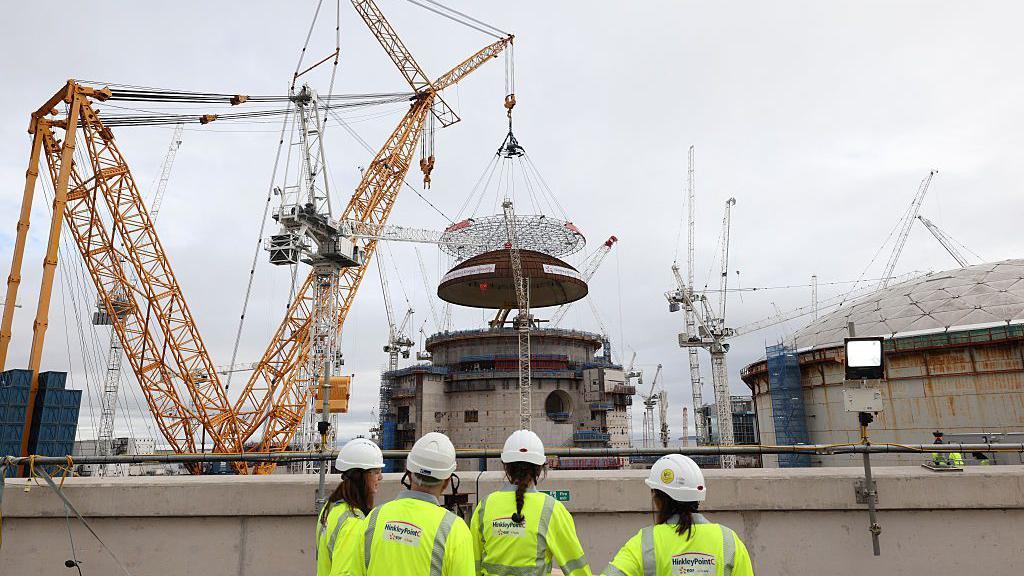UK 'world's most expensive place' to develop nuclear power

The Sizewell nuclear power station
- Published
The UK has become the "most expensive place in the world" to build nuclear power plants, according to a government review detailing the "overly complex" bureaucracy around the sector.
The report, which was commissioned by Prime Minister Sir Keir Starmer, called for a "radical reset" in the government's nuclear strategy to make projects safer and more efficient.
Doing so could save Britain "tens of billions" in costs and reverse the industry's "decline" in recent years, the Nuclear Regulatory Taskforce found, external.
It comes as the UK government looks to build a new generation of nuclear plans to meet the country's future energy needs and net zero targets.
The report found that a "fragmented" regulatory system has resulted in a lack of industry-wide safety oversight, which has led to "conservative and costly decisions not proportionate to the actual risk being managed".
It described the industry as "near-monopolistic", and said both civil and defence programmes are prone to "large cost overruns and schedule delays".
Nuclear plants - which generate electricity by using atomic reactions to produce heat - are "essential to the UK's future", with the country at risk of missing out on a "worldwide nuclear renaissance".
The report said the UK has excessively risk-averse policies in place, including "overly conservative" rules on radiation exposure levels for workers.
How does nuclear power work and why is the UK investing in it?
- Published22 July
What is net zero and is the UK on track to achieve it?
- Published5 November
Among its recommendations is a "one-stop" commission for nuclear decisions. The agency should have "unified" decision-making powers.
Taskforce chair John Fingleton said: "Our solutions are radical, but necessary. By simplifying regulation, we can maintain or enhance safety standards while finally delivering nuclear capacity safely, quickly, and affordably."
The government is expected to address the report's findings later this month in the Budget.
Several major economies are reassessing their nuclear strategies and expanding capacity.
The number of planned and proposed nuclear plants currently in the works is roughly equivalent to the number already in operation around the world.
The UK is among 30 other countries that have signed a global pledge to triple their nuclear capacity by 2050 in a bid to cut carbon emissions.
Britain's existing nuclear power stations account for about 15% of the electricity generated in 2024.
The UK runs nine nuclear reactors but they are ageing, with eight set to shut by 2030.
New plants are being developed but they will take several years to come online.

Hinkley Point C in Somerset is under contruction
Hinkley Point C in Somerset is expected to start operating in the early 2030s, while Sizewell C - which the government says will capable of powering six million homes - will follow later that decade.
The UK is also setting up small nuclear power stations, which are faster to build than full-size reactors.
Beyond the UK, France plans to build at least six new reactors, while China has nearly 30 under construction.
The US completed its first new reactor in over three decades last year, and Japan - which temporarily shuttered its nuclear programme after the 2011 meltdown at Fukushima - now plans for it to supply a fifth of its electricity by 2040.
In contrast, Germany has phased out its use of nuclear power, prioritising alternative renewables like hydrogen.
The development of nuclear energy remains divisive, with public opinion shaded by high-profile safety incidents, including Fukushima and the 1969 disaster at Chernobyl.